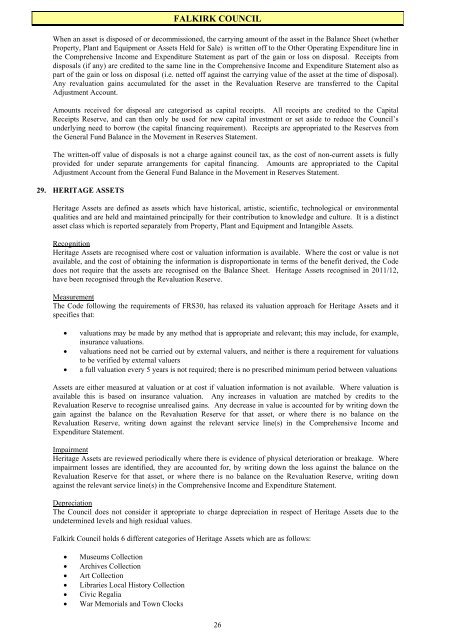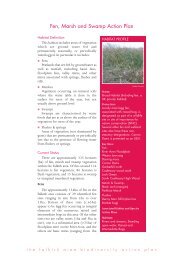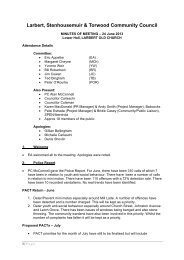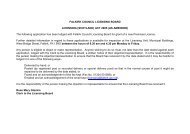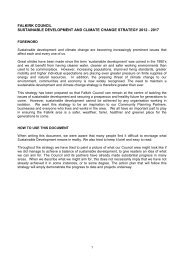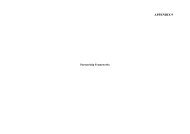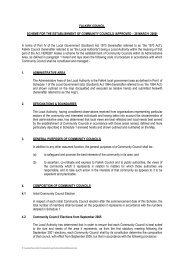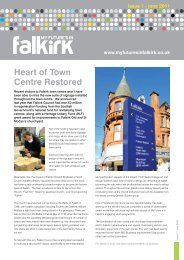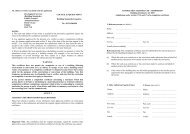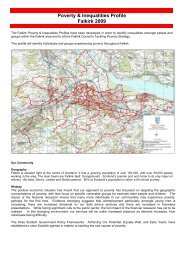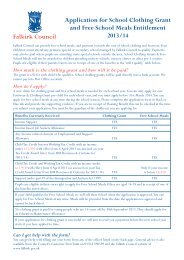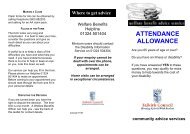2011/2012 audited annual accounts - Falkirk Council
2011/2012 audited annual accounts - Falkirk Council
2011/2012 audited annual accounts - Falkirk Council
Create successful ePaper yourself
Turn your PDF publications into a flip-book with our unique Google optimized e-Paper software.
FALKIRK COUNCIL<br />
When an asset is disposed of or decommissioned, the carrying amount of the asset in the Balance Sheet (whether<br />
Property, Plant and Equipment or Assets Held for Sale) is written off to the Other Operating Expenditure line in<br />
the Comprehensive Income and Expenditure Statement as part of the gain or loss on disposal. Receipts from<br />
disposals (if any) are credited to the same line in the Comprehensive Income and Expenditure Statement also as<br />
part of the gain or loss on disposal (i.e. netted off against the carrying value of the asset at the time of disposal).<br />
Any revaluation gains accumulated for the asset in the Revaluation Reserve are transferred to the Capital<br />
Adjustment Account.<br />
Amounts received for disposal are categorised as capital receipts. All receipts are credited to the Capital<br />
Receipts Reserve, and can then only be used for new capital investment or set aside to reduce the <strong>Council</strong>’s<br />
underlying need to borrow (the capital financing requirement). Receipts are appropriated to the Reserves from<br />
the General Fund Balance in the Movement in Reserves Statement.<br />
The written-off value of disposals is not a charge against council tax, as the cost of non-current assets is fully<br />
provided for under separate arrangements for capital financing. Amounts are appropriated to the Capital<br />
Adjustment Account from the General Fund Balance in the Movement in Reserves Statement.<br />
29. HERITAGE ASSETS<br />
Heritage Assets are defined as assets which have historical, artistic, scientific, technological or environmental<br />
qualities and are held and maintained principally for their contribution to knowledge and culture. It is a distinct<br />
asset class which is reported separately from Property, Plant and Equipment and Intangible Assets.<br />
Recognition<br />
Heritage Assets are recognised where cost or valuation information is available. Where the cost or value is not<br />
available, and the cost of obtaining the information is disproportionate in terms of the benefit derived, the Code<br />
does not require that the assets are recognised on the Balance Sheet. Heritage Assets recognised in <strong>2011</strong>/12,<br />
have been recognised through the Revaluation Reserve.<br />
Measurement<br />
The Code following the requirements of FRS30, has relaxed its valuation approach for Heritage Assets and it<br />
specifies that:<br />
• valuations may be made by any method that is appropriate and relevant; this may include, for example,<br />
insurance valuations.<br />
• valuations need not be carried out by external valuers, and neither is there a requirement for valuations<br />
to be verified by external valuers<br />
• a full valuation every 5 years is not required; there is no prescribed minimum period between valuations<br />
Assets are either measured at valuation or at cost if valuation information is not available. Where valuation is<br />
available this is based on insurance valuation. Any increases in valuation are matched by credits to the<br />
Revaluation Reserve to recognise unrealised gains. Any decrease in value is accounted for by writing down the<br />
gain against the balance on the Revaluation Reserve for that asset, or where there is no balance on the<br />
Revaluation Reserve, writing down against the relevant service line(s) in the Comprehensive Income and<br />
Expenditure Statement.<br />
Impairment<br />
Heritage Assets are reviewed periodically where there is evidence of physical deterioration or breakage. Where<br />
impairment losses are identified, they are accounted for, by writing down the loss against the balance on the<br />
Revaluation Reserve for that asset, or where there is no balance on the Revaluation Reserve, writing down<br />
against the relevant service line(s) in the Comprehensive Income and Expenditure Statement.<br />
Depreciation<br />
The <strong>Council</strong> does not consider it appropriate to charge depreciation in respect of Heritage Assets due to the<br />
undetermined levels and high residual values.<br />
<strong>Falkirk</strong> <strong>Council</strong> holds 6 different categories of Heritage Assets which are as follows:<br />
• Museums Collection<br />
• Archives Collection<br />
• Art Collection<br />
• Libraries Local History Collection<br />
• Civic Regalia<br />
• War Memorials and Town Clocks<br />
26


